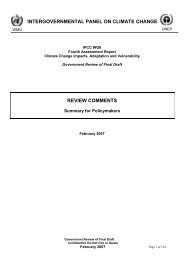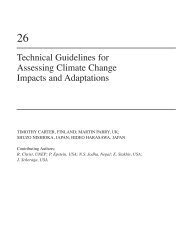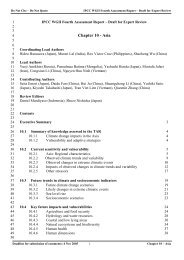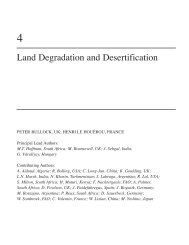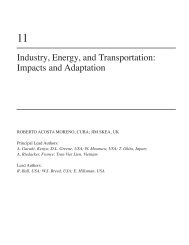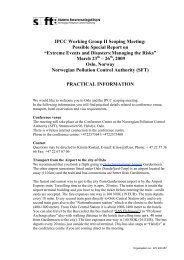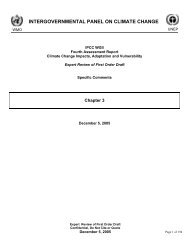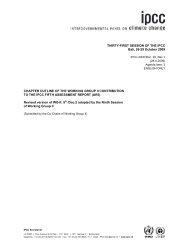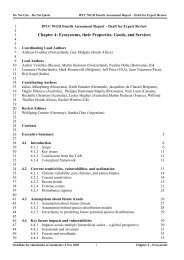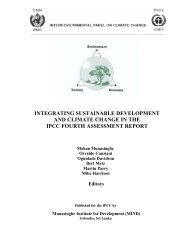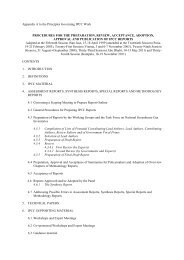IPCC Expert Meeting on Geoengineering
IPCC Expert Meeting on Geoengineering
IPCC Expert Meeting on Geoengineering
Create successful ePaper yourself
Turn your PDF publications into a flip-book with our unique Google optimized e-Paper software.
Annex 5: Breakout Group Reports<br />
Breakout Group I.3: Carb<strong>on</strong> Dioxide Removal Opti<strong>on</strong>s and Methods<br />
Chair: Peter Haugan<br />
Rapporteur: Johannes Lehmann<br />
The summary that follows, written by the Chair and Rapporteur, characterizes the main points of the BOG I.3 discussi<strong>on</strong>. It<br />
may not reflect the pers<strong>on</strong>al views of the BOG’s Chair and Rapporteur. The summary is intended for c<strong>on</strong>siderati<strong>on</strong> by <str<strong>on</strong>g>IPCC</str<strong>on</strong>g><br />
authors of the Fifth Assessment Report (AR5), but is neither endorsed nor approved by the <str<strong>on</strong>g>IPCC</str<strong>on</strong>g> or its Working Groups.<br />
Participants in the BOG c<strong>on</strong>sidered a series of questi<strong>on</strong>s related to geoengineering research, developed by the meeting’s<br />
Scientific Steering Group.<br />
Questi<strong>on</strong>s suggested for discussi<strong>on</strong>:<br />
<br />
<br />
<br />
What are the most important Carb<strong>on</strong> Dioxide Removal approaches that <str<strong>on</strong>g>IPCC</str<strong>on</strong>g> authors might want to c<strong>on</strong>sider in<br />
the AR5?<br />
What are the most important aspects of these approaches to evaluate (e.g., physical impacts, time scales, system<br />
boundaries, spatial scales, direct/private costs)?<br />
Can the most important aspects of these issues be supported by reference to the peer-reviewed literature, ideally<br />
drawing from multiple lines of independent evidence? What is the available evidence and what are relevant<br />
references?<br />
Introducti<strong>on</strong><br />
This BOG’s discussi<strong>on</strong> c<strong>on</strong>centrated <strong>on</strong> identifying major Carb<strong>on</strong> Dioxide Removal (CDR) approaches that might be<br />
c<strong>on</strong>sidered in the AR5, evaluating issues relevant to development and implementati<strong>on</strong> of the approaches, and c<strong>on</strong>sidering<br />
the peer-reviewed literature <strong>on</strong> development aspects. In additi<strong>on</strong>, the group spent time discussing the terminology of<br />
geoengineering.<br />
What are the most important Carb<strong>on</strong> Dioxide Removal approaches that <str<strong>on</strong>g>IPCC</str<strong>on</strong>g> authors might want to<br />
c<strong>on</strong>sider in the AR5?<br />
The group wrestled with whether the terms “geoengineering” and even “Carb<strong>on</strong> Dioxide Removal” are appropriate<br />
organizing principles for associated technologies within the c<strong>on</strong>text of the <str<strong>on</strong>g>IPCC</str<strong>on</strong>g> or nati<strong>on</strong>al debates. While the choice of<br />
terminology may at this juncture be unavoidable for multiple reas<strong>on</strong>s (historical development, risk of “white-washing”,<br />
etc.), the organizing principle may benefit from rethinking.<br />
The unifying characteristic of currently grouped CDR approaches is creati<strong>on</strong> of a storage issue. This can be used as a highlevel<br />
organizing principle to distinguish with Solar Radiati<strong>on</strong> Management (SRM). Other organizing principles worth<br />
c<strong>on</strong>sidering include the following:<br />
<str<strong>on</strong>g>IPCC</str<strong>on</strong>g> <str<strong>on</strong>g>Expert</str<strong>on</strong>g> <str<strong>on</strong>g>Meeting</str<strong>on</strong>g> <strong>on</strong> <strong>Geoengineering</strong> - 74



